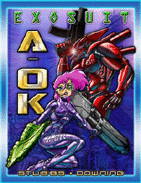
|
About OgreCave and its staff
|

|
by Cedric Chin
Deep7's 1PG line of games has a simple premise: take a cool movie cliché, generate characters in a few minutes, and put the rules for play on the character sheet. In the case of Exosuit AOK, the cliché is the serious action/hardsuit adventure of anime shows such as Bubblegum Crisis, Appleseed, and Robotech. The rules should work for any sort of action adventure, from an episode of Chips to The Fifth Element. AOK is a thirteen-page PDF. Each section of the game fits onto one page:
Rules of Play and Character Sheet The check is the basic success roll in the game: The player rolls 1d6 against the appropriate stat or skill + stat. A 1 is always a failure, and 6 always a success. Damage is taken from Blood, and Armor uses damage reduction. In case of a conflict (eg. fighting), whoever has a greater margin of success wins. With secondary stats Guts, Cool, and Reputation, AOK goes beyond traditional physical abilities. Each player has 1d3+2 Guts and 1d6 Cool. In case of panic and stress, a PC will make a Guts check. Failure results in loss of one Cool. For Reputation, each player makes a check against each primary attribute during character generation. The total number of successful checks is his Reputation. A player makes a check against his Reputation whenever he wishes to pull a few favors from his fans or local authorities. The entire Rules of Play, including Character Generation, fit on one sheet. Despite all the new terminology, the one-page character and reference sheet make these terms - and game mechanics - quite clear. (And since this is a PDF, the GM can print out a copy of the rules sheet and character sheet for each player.) PCs are meant to only be used for one gaming session, although rules are included for character development. The 1PG Companion can be used for additional rules, such as vehicles combat, NPCs, and additional character development rules. Note that, although this is an anime action roleplaying game, it lacks mechanics for the traditional anime scene where the hero, battered and bruised, summons his last inner strength and defeats all odds. It's also entirely possible for the random generation tables to create characters with odd background and equipment ("Hey, I'm an Entertainer and Street Fighter with a Helicopter!).
Exosuit Construction & Operation Despite the word "Exosuit" in the game's title, exosuit combat uses the same skill checks as regular conflict. No rules reflect the complexity often seen in anime mecha combat (eg. tactics, broken weapons, weaknesses, critical hits). Roleplayers who would rather be out of their suits won't notice, but action otaku looking forward to mecha combat may be disappointed.
For the Ref
Scenarios Like the mechanics, the scenarios are tailored towards policework and missions, not humor and character development. Sailor Moon this is not. The scenarios are also unrelated, meaning that characters from one scenario cannot (without some rewriting) be played in another. (Remember that characters are meant to be played for only one game session.)
Conclusions
|
||
 Exosuit AOK
Exosuit AOK